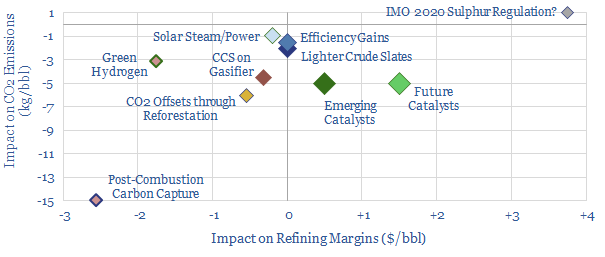Refining has the highest carbon footprint in global energy. Next-generation catalysts are the best opportunity for improvement: uniquely, they could cut refineries’ CO2 by 15-30%, while also uplifting margins, which get obliterated by other decarbonisation approaches. Catalyst science is undergoing a digitally driven transformation. Hence this 25-page note outlines a new ESG opportunity around refining catalyst technologies. Industry leaders are also identified.
Pages 2-3 outline the need to decarbonise the refining industry, in order to clean up the world’s future oil production and preserve access to capital.
Pages 4-6 decompose the sources of CO2 emissions across a typical refinery, process-by-process; as a function of heat, utilities and hydrogen.
Page 7-8 outline small opportunities to improve refinery CO2 intensities, via continued process enhancements, changing crude slates and renewable energy.
Page 9 finds green hydrogen can reduce CO2 emissions by c7-15%, but economics are unfavorable, obliterating refining margins.
Pages 10-12 models the costs of post-combustion carbon capture, which could cut CO2 intensities by 25-90%, but also risks cutting margins by $2-4/bbl.
Pages 13-14 present the opportunity for better catalysts, identifying which Energy Majors have the leading refining technologies, based on patent filings.
Pages 15-17 outline the most promising, emerging catalyst technologies from 50 patents we studied. They can reduce refinery CO2 intensities by 5kg/bbl.
Pages 18-21 highlight breakthrough, digital technologies to improve the development of new catalysts, including super-computing and machine learning techniques.
Pages 23-24 screen 35 leading catalyst companies, including Super-Majors, chemicals companies and earlier-stage pure-plays.
